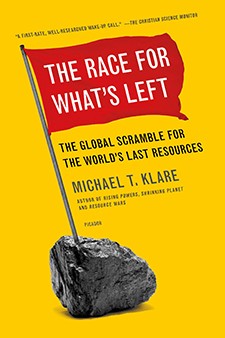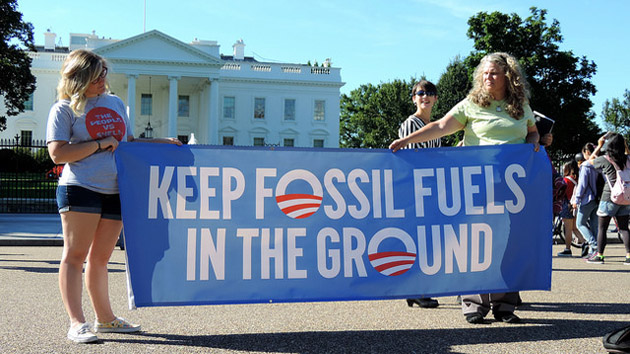
<a href="http://www.shutterstock.com/pic-115628464/stock-photo-oil-pumping-unit-at-sunset-time.html?src=K2lvXx4psAbScRLgqsum9Q-1-52">Huyangshu</a>/Shutterstock
This story originally appeared on TomDispatch.
Here’s the good news: Wind power, solar power, and other renewable forms of energy are expanding far more quickly than anyone expected, ensuring that these systems will provide an ever-increasing share of our future energy supply. According to the most recent projections from the Energy Information Administration (EIA) of the US Department of Energy, global consumption of wind, solar, hydropower, and other renewables will double between now and 2040, jumping from 64 to 131 quadrillion British thermal units (BTUs).
And here’s the bad news: The consumption of oil, coal, and natural gas is also growing, making it likely that, whatever the advances of renewable energy, fossil fuels will continue to dominate the global landscape for decades to come, accelerating the pace of global warming and ensuring the intensification of climate-change catastrophes.
The rapid growth of renewable energy has given us much to cheer about. Not so long ago, energy analysts were reporting that wind and solar systems were too costly to compete with oil, coal, and natural gas in the global marketplace. Renewables would, it was then assumed, require pricey subsidies that might not always be available. That was then and this is now. Today, remarkably enough, wind and solar are already competitive with fossil fuels for many uses and in many markets.
If that wasn’t predicted, however, neither was this: Despite such advances, the allure of fossil fuels hasn’t dissipated. Individuals, governments, whole societies continue to opt for such fuels even when they gain no significant economic advantage from that choice and risk causing severe planetary harm. Clearly, something irrational is at play. Think of it as the fossil-fuel equivalent of an addictive inclination writ large.
The contradictory and troubling nature of the energy landscape is on clear display in the 2016 edition of the International Energy Outlook, the annual assessment of global trends released by the EIA this May. The good news about renewables gets prominent attention in the report, which includes projections of global energy use through 2040. “Renewables are the world’s fastest-growing energy source over the projection period,” it concludes. Wind and solar are expected to demonstrate particular vigor in the years to come, their growth outpacing every other form of energy. But because renewables start from such a small base—representing just 12 percent of all energy used in 2012—they will continue to be overshadowed in the decades ahead, explosive growth or not. In 2040, according to the report’s projections, fossil fuels will still have a grip on a staggering 78 percent of the world energy market, and—if you don’t mind getting thoroughly depressed—oil, coal, and natural gas will each still command larger shares of the market than all renewables combined.
Keep in mind that total energy consumption is expected to be much greater in 2040 than at present. Humanity will be using an estimated 815 quadrillion BTUs (compared to approximately 600 quadrillion today). In other words, though fossil fuels will lose some of their market share to renewables, they will still experience striking growth in absolute terms. Oil consumption, for example, is expected to increase by 34 percent—from 90 million to 121 million barrels per day. Despite all the negative publicity it’s been getting lately, coal, too, should experience substantial growth, rising from 153 to 180 quadrillion BTUs in “delivered energy” over this period. And natural gas will be the fossil-fuel champ, with global demand for it jumping by 70 percent. Put it all together and the consumption of fossil fuels is projected to increase by 38 percent over the period the report surveys.
Anyone with even the most rudimentary knowledge of climate science has to shudder at such projections. After all, emissions from the combustion of fossil fuels account for approximately three-quarters of the greenhouse gases humans are putting into the atmosphere. An increase in their consumption of such magnitude will have a corresponding impact on the greenhouse effect that is accelerating the rise in global temperatures.
At the UN Climate Summit in Paris last December, delegates from more than 190 countries adopted a plan aimed at preventing global warming from exceeding 2 degrees Celsius (about 3.6 degrees Fahrenheit) above the pre-industrial level. This target was chosen because most scientists believe that any warming beyond that will result in catastrophic and irreversible climate effects, including the melting of the Greenland and Antarctic ice caps (and a resulting sea-level rise of 10-20 feet). Under the Paris Agreement, the participating nations signed onto a plan to take immediate steps to halt the growth of greenhouse gas emissions and then move to actual reductions. Although the agreement doesn’t specify what measures should be taken to satisfy this requirement—each country is obliged to devise its own “intended nationally determined contributions” to the overall goal—the only practical approach for most countries would be to reduce fossil fuel consumption.
As the EIA report makes eye-poppingly clear, however, the endorsers of the Paris Agreement aren’t on track to reduce their consumption of oil, coal, and natural gas. In fact, greenhouse gas emissions are expected to rise by an estimated 34 percent between 2012 and 2040. The predicted net increase of 10.9 billion metric tons is equal to the total carbon emissions of the United States, Canada, and Europe in 2012. If such projections prove accurate, global temperatures will rise, possibly significantly above that 2 degree mark, with the destructive effects of climate change we are already witnessing today—the fires, heat waves, floods, droughts, storms, and sea level rise—only intensifying.
How to explain explain the world’s tenacious reliance on fossil fuels, despite all that we know about their role in global warming and those lofty promises made in Paris?

To some degree, it is undoubtedly the product of built-in momentum: our existing urban, industrial, and transportation infrastructure was largely constructed around fossil fuel-powered energy systems, and it will take a long time to replace or reconfigure them for a post-carbon future. Most of our electricity, for example, is provided by coal- and gas-fired power plants that will continue to operate for years to come. Even with the rapid growth of renewables, coal and natural gas are projected to supply 56 percent of the fuel for the world’s electrical power generation in 2040 (a drop of only 5 percent from today). Likewise, the overwhelming majority of cars and trucks on the road are now fueled by gasoline and diesel. Even if the number of new ones running on electricity were to spike, it would still be many years before oil-powered vehicles lost their commanding position. As history tells us, transitions from one form of energy to another take time.
Then there’s the problem—and what a problem it is!—of vested interests. Energy is the largest and most lucrative business in the world, and the giant fossil fuel companies have long enjoyed a privileged and highly profitable status. Oil corporations like Chevron and ExxonMobil, along with their state-owned counterparts like Gazprom of Russia and Saudi Aramco, are consistently ranked among the world’s most valuable enterprises. These companies—and the governments they’re associated with—are not inclined to surrender the massive profits they generate year after year for the future well-being of the planet.
As a result, it’s a guarantee that they will employ any means at their disposal (including well-established, well-funded ties to friendly politicians and political parties) to slow the transition to renewables. In the United States, for example, the politicians of coal-producing states are now at work on plans to block the Obama administration’s “clean power” drive, which might indeed lead to a sharp reduction in coal consumption. Similarly, Exxon has recruited friendly Republican officials to impede the efforts of some state attorney generals to investigate that company’s past suppression of information on the links between fossil fuel use and climate change. And that’s just to scratch the surface of corporate efforts to mislead the public that have included the funding of the Heartland Institute and other climate-change-denying think tanks.
Of course, nowhere is the determination to sustain fossil fuels fiercer than in the “petro-states” that rely on their production for government revenues, provide energy subsidies to their citizens, and sometimes sell their products at below-market rates to encourage their use. According to the International Energy Agency, in 2014 fossil fuel subsidies of various sorts added up to a staggering $493 billion worldwide—far more than those for the development of renewable forms of energy. The G-20 group of leading industrial powers agreed in 2009 to phase out such subsidies, but a meeting of G-20 energy ministers in Beijing in June failed to adopt a timeline to complete the phase-out process, suggesting that little progress will be made when the heads of state of those countries meet in Hangzhou, China, this September.
None of this should surprise anyone, given the global economy’s institutionalized dependence on fossil fuels and the amounts of money at stake. What it doesn’t explain, however, is the projected growth in global fossil fuel consumption. A gradual decline, accelerating over time, would be consistent with a broad-scale but slow transition from carbon-based fuels to renewables. That the opposite seems to be happening, that their use is actually expanding in most parts of the world, suggests that another factor is in play: addiction.
We all know that smoking tobacco, snorting cocaine, or consuming too much alcohol is bad for us, but many of us persist in doing so anyway, finding the resulting thrill, the relief, or the dulling of the pain of everyday life simply too great to resist. In the same way, much of the world now seems to find it easier to fill up the car with the usual tankful of gasoline or flip the switch and receive electricity from coal or natural gas than to begin to shake our addiction to fossil fuels. As in everyday life, so at a global level, the power of addiction seems regularly to trump the obvious desirability of embarking on another, far healthier path.
Without acknowledging any of this, the 2016 EIA report indicates just how widespread and prevalent our fossil-fuel addiction remains. In explaining the rising demand for oil, for example, it notes that “in the transportation sector, liquid fuels [predominantly petroleum] continue to provide most of the energy consumed.” Even though “advances in nonliquids-based [electrical] transportation technologies are anticipated,” they will not prove sufficient “to offset the rising demand for transportation services worldwide,” and so the demand for gasoline and diesel will continue to grow.
Most of the increase in demand for petroleum-based fuels is expected to occur in the developing world, where hundreds of millions of people are entering the middle class, buying their first gas-powered cars, and about to be hooked on an energy way of life that should be, but isn’t, dying. Oil use is expected to grow in China by 57 percent from 2012 to 2040, and at a faster rate (131 percent!) in India. Even in the United States, however, a growing preference for sport utility vehicles and pickup trucks continues to mean higher petroleum use. In 2016, according to Edmunds.com, nearly 75 percent of the people who traded in a hybrid or electric car to a dealer replaced it with an all-gas car, typically a larger vehicle like an SUV or a pickup.
The rising demand for coal follows a depressingly similar pattern. Although it remains a major source of the greenhouse gases responsible for climate change, many developing nations, especially in Asia, continue to favor it when adding electricity capacity because of its low cost and familiar technology. Although the demand for coal in China—long the leading consumer of that fuel—is slowing, that country is still expected to increase its usage by 12 percent by 2035. The big story here, however, is India: According to the EIA, India’s coal consumption will grow by 62 percent in the years surveyed, eventually making it, not the United States, the world’s second-largest consumer. Most of that extra coal will go for electricity generation, once again to satisfy an “expanding middle class using more electricity-consuming appliances.”
And then there’s the mammoth expected increase in the demand for natural gas. According to the EIA’s latest projections, gas consumption will rise faster than any fuel except renewables, and experience the biggest absolute increase of any fuel. At present, natural gas appears to enjoy an enormous advantage in the global energy marketplace. “In the power sector, natural gas is an attractive choice for new generating plants given its moderate capital cost and attractive pricing in many regions as well as the relatively high fuel efficiency and moderate capital cost of gas-fired plants,” the EIA notes. It is also said to benefit from its “clean” reputation (compared to coal) in generating electricity. “As more governments begin implementing national or regional plans to reduce carbon dioxide emissions, natural gas may displace consumption of the more carbon-intensive coal and liquid fuels.”
Unfortunately, despite that reputation, natural gas remains a carbon-based fossil fuel, and its expanded consumption will result in a significant increase in global greenhouse gas emissions. In fact, the EIA claims that it will generate a larger increase in such emissions over the next quarter-century than either coal or oil—a disturbing note for those who contend that natural gas provides a “bridge” to a green energy future.
If you were to read through the EIA’s latest report as I did, you, too, might end up depressed by humanity’s addictive need for its daily fossil fuel hit. While the EIA’s analysts add the usual caveats, including the possibility that a more sweeping than expected follow-up climate agreement or strict enforcement of the one adopted last December could alter their projections, they detect no signs of the beginning of a determined move away from the reliance on fossil fuels.
If, indeed, addiction is a big part of the problem, any strategies undertaken to address climate change must incorporate a treatment component. Simply saying that global warming is bad for the planet, and that prudence and morality oblige us to prevent the worst climate-related disasters, will no more suffice than would telling addicts that tobacco and hard drugs are bad for them. Success in any global drive to avert climate catastrophe will involve tackling addictive behavior at its roots and promoting lasting changes in lifestyle. To do that, it will be necessary to learn from the anti-drug and anti-tobacco communities about best practices, and apply them to fossil fuels.
Consider, for example, the case of anti-smoking efforts. It was the medical community that first took up the struggle against tobacco and began by banning smoking in hospitals and other medical facilities. This effort was later extended to public facilities—schools, government buildings, airports, and so on—until vast areas of the public sphere became smoke-free. Anti-smoking activists also campaigned to have warning labels displayed in tobacco advertising and cigarette packaging.
Such approaches helped reduce tobacco consumption around the world and can be adapted to the anti-carbon struggle. College campuses and town centers could, for instance, be declared car-free—a strategy already embraced by London’s newly elected mayor, Sadiq Khan. Express lanes on major streets and highways can be reserved for hybrids, electric cars, and other alternative vehicles. Gas station pumps and oil advertising can be made to incorporate warning signs saying something like, “Notice: Consumption of this product increases your exposure to asthma, heat waves, sea level rise, and other threats to public health.” Once such an approach began to be seriously considered, there would undoubtedly be a host of other ideas for how to begin to put limits on our fossil fuel addiction.
Such measures would have to be complemented by major moves to combat the excessive influence of the fossil fuel companies and energy states when it comes to setting both local and global policy. In the US, for instance, severely restricting the scope of private donations in campaign financing, as Senator Bernie Sanders advocated in his presidential campaign, would be a way to start down this path. Another would step up legal efforts to hold giant energy companies like ExxonMobil accountable for malfeasance in suppressing information about the links between fossil fuel combustion and global warming, just as, decades ago, anti-smoking activists tried to expose tobacco company criminality in suppressing information on the links between smoking and cancer.
Without similar efforts of every sort on a global level, one thing seems certain: The future projected by the EIA will indeed come to pass and human suffering of a previously unimaginable sort will be the order of the day.
Michael T. Klare, a TomDispatch regular, is a professor of peace and world security studies at Hampshire College and the author, most recently, of The Race for What’s Left. A documentary based on his book Blood and Oil is available from the Media Education Foundation. Follow him on Twitter at @mklare1.
















